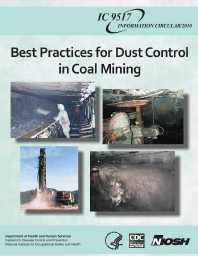Mining Product: Best Practices for Dust Control in Coal Mining
Original creation date: January 2010
In light of the ongoing severity of these lung diseases in coal mining, this handbook was developed to identify available engineering controls that can help the industry reduce worker exposure to respirable coal and silica dust. The controls discussed in this handbook range from long-utilized controls that have developed into industry standards to newer controls that are still being optimized. The intent was to identify the best practices that are available to control respirable dust levels in underground and surface coal mining operations. This handbook provides general information on the control technologies along with extensive references.
Authors: JF Colinet, JP Rider, JM Listak, JA Organiscak, AL Wolfe
Information Circular - January 2010
NIOSHTIC2 Number: 20036296
Pittsburgh, PA: U.S. Department of Health and Human Services, Public Health Service, Centers for Disease Control and Prevention, National Institute for Occupational Safety and Health, DHHS (NIOSH) Publication No. 2010-110, Information Circular 9517, 2010 Jan; :1-76
See Also
- Benchmarking Longwall Dust Control Technology and Practices
- Best Practices for Dust Control in Metal/Nonmetal Mining
- Coal Dust Explosibility Meter Evaluation and Recommendations for Application
- Coal Mine Explosion Prevention
- Control of Respirable Dust
- Determining the Spatial Variability of Personal Sampler Inlet Locations
- Dust Control Handbooks for Coal Mining and Metal/Nonmetal Mining
- Equivalency of a Personal Dust Monitor to the Current United States Coal Mine Respirable Dust Sampler
- Evaluation of the Approach to Respirable Quartz Exposure Control in U.S. Coal Mines
- Respirable Dust
- Respiratory Diseases
- Rock Dusting Considerations in Underground Coal Mines
- Status of a Tapered Element, Oscillation Microbalance-Based Continuous Respirable Coal Mine Dust Monitor
- Content source: National Institute for Occupational Safety and Health, Mining Program


 ShareCompartir
ShareCompartir
